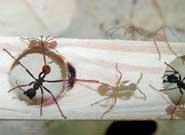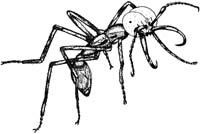Many scientists have argued that only humans show true altruistic behaviour. But a group of Ugandan chimps is set to change all that by showing clear signs of true selflessness, helping other unrelated chimps with no desire for reward.
Why do we help each other, instead of constantly looking out for ourselves? This is one of the most compelling questions in modern biology. Evolutionary and game theory alike predict that selfish behaviour should be the rule with altruism the exception, and animal experiments have largely supported this idea.
 Nature, ‘red in tooth and claw’, is painted as a fierce competition between selfish individuals and their even more selfish genes. In this stark landscape, true altruism is a rare quality and some scientists believe that it’s one that only we humans possess.
Nature, ‘red in tooth and claw’, is painted as a fierce competition between selfish individuals and their even more selfish genes. In this stark landscape, true altruism is a rare quality and some scientists believe that it’s one that only we humans possess.
Even our closest relatives, chimpanzees, are not exempt from this dividing line. Certainly, there is a large amount of anecdotal evidence of chimps helping each other or even saving each others’ lives. But some thinkers believe that this behaviour, along with other seemingly selfless animal acts, is actually self-serving in one of two ways.
The chimps could be helping their relatives in order to advanced the spread of its own genes, which family members are likely to share. Or they could be doing a favour for another individual, in the knowledge that it will be repaid later on. Either way, it’s the do-gooder that eventually benefits.
Humans, on the other hand, seem to flaunt this rule. We often help others who are not relatives and who are unlikely to repay the favour. We go out of our way to be helpful, and sometimes even risk personal harm to do so.
Two tests for altruism
Now, Felix Warneken and colleagues form the Max Planck Institute for Evolutionary Anthropology have found compelling evidence that we are not alone. Contrary to previous studies, they have found that chimps also behave altruistically in a very human way. They help out unrelated strangers without expectation of reward, and even go to great lengths to do so.
Warneken studied 36 chimps at Ngamba Island Chimpanzee Sanctuary, Uganda and looked at their willingness to help a human handler. To minimise the effect of any human-chimp bond, he only looked at chimps that were born in the wild, and used experimenters who the chimps had never seen before.
 In the first test, the chimps saw a human unsuccessfully trying to reach a stick that they themselves could reach. Warneken found that chimps were all too happy to pass the stick across (video), regardless of whether they were rewarded with a banana or not. In fact, the only thing that affected their readiness to lend a hand was whether the human was struggling for the stick or just passively staring at it.
In the first test, the chimps saw a human unsuccessfully trying to reach a stick that they themselves could reach. Warneken found that chimps were all too happy to pass the stick across (video), regardless of whether they were rewarded with a banana or not. In fact, the only thing that affected their readiness to lend a hand was whether the human was struggling for the stick or just passively staring at it.
He found the same thing when he ran a similar set-up with a 36 eighteen-month-old human toddlers, but with toy cubes in lieu of sticks (video). At that age, a baby’s mental abilities are thought to similar to those of chimps, and indeed the only real difference between the two was that the babies were quicker with their assistance.
Passing a stick across is obviously fairly easy but would altruism persist if there was effort involved? Warneken tested this by changing the experiment so that the chimps had to climb over a raceway (video) and the toddlers had to walk past a series of obstacles (video). Those that helped in the first test were happy to do so in the second, again without any rewards.
The third and most important test
A skeptic might argue that this doesn’t show anything. During their stay at the sanctuary, the chimps could have learned that helping any one of their strange two-legged keepers was worth it. The acid test then, was to see if the chimps would help each other.
The first chimp – the subject – could only get into a room with food by lifting the chain attached to its door. But it couldn’t reach the chain – only a second chimp, the observer, could do that. And once again, the chimps proved their selflessness, lifting the chain for their fellow chimps the vast majority of the time (video).
 This striking result flies in the face of other studies, which have failed to find altruistic behaviour between chimps. But in a related commentary, Frans de Waal, an international expert of ape behaviour, claimed that these were more tests of generosity than selfishness.
This striking result flies in the face of other studies, which have failed to find altruistic behaviour between chimps. But in a related commentary, Frans de Waal, an international expert of ape behaviour, claimed that these were more tests of generosity than selfishness.
They created specific situations where chimps were motivated to look out for themselves and the species can’t be judged on these scenarios alone. It would be like claiming that all people are selfish after watching the self-interested behaviour of commuters. Failing to show altruism is not the same as proving that it doesn’t happen.
But it does happen – Warneken’s experiments are striking indicators of that. In the third test, the chimps were unrelated, the observer had no chance of getting a share of the food, and their roles were never reversed so there were no opportunities for payback. Clearly, humans are not alone in our desire to help each other. Chimps are now our fellows in altruism and it’s likely that our common ancestor did the same.
What this means for the altruism debate
It’s particularly fascinating that rewards in the first two tests didn’t affect the chimps’ behaviour. This suggests that chimps don’t continually analyse the pros and cons of helping their fellow – if they did, the reward would have motivated them to help even more often.
Instead, de Waal believes that the chimps have evolved psychological systems that steer them towards selflessness. In essence, natural selection has done the analysis for them and decided that altruistic behaviour works to its advantage in the long run. Selfless behaviour then, can evolve for selfish reasons, and that strikes to the very core of the debate on altruism.
Spend enough time reading about this field of research, and you could be forgiven for thinking that some scientists are taking cynical glee at ‘explaining away’ altruism. The extreme reductionist view is that discovering the evolutionary origins of selfless behaviour discredits that behaviour, somehow making it less worthy. As Robert Trivers put it, these models are designed to “take the altruism out of altruism”.
 But this viewpoint is blinkered and too focused on the past. Evolutionary explanations can help us understand where an unusual behaviour like selflessness comes from, but they do not alter the value of those behaviours. They can tell us about how a behaviour arose, but not about an animal’s reasons for behaving in that way here and now.
But this viewpoint is blinkered and too focused on the past. Evolutionary explanations can help us understand where an unusual behaviour like selflessness comes from, but they do not alter the value of those behaviours. They can tell us about how a behaviour arose, but not about an animal’s reasons for behaving in that way here and now.
Take sex. Its adaptive benefits are clear – it continues the line and promotes genetic diversity. But animals don’t consider the issue of reproduction every time they have sex and for the most part, humans actively deny it!
According to de Waal, we should now turn our attention to the psychological processes that foster altruism in chimps, and how they are different from those that work in our own minds. Do chimps share our strong sense of empathy, that fuels selflessness by letting us identify with the emotions and needs of others. Do their cultures, like ours, punish and vilify selfish behaviour?
References: Warneken, Hare, Melis, Hanus & Tomasello. 2007. Spontaneous altruism by chimpanzees and young children. PLOS Biology 5: e184.
de Waal. 2007. With a little help from a friend. PLOS Biology 5: e190.
Related posts on chimps:
Chimps show that actions spoke louder than words in language evolution
Not so unique – the chimpanzee Stone Age, and our place among intelligent animals
Cultured chimps pass on new traditions between groups
Chimpanzees make spears to hunt bushbabies
Related posts on altruism:
Army ants plug potholes with their own bodies
Images: from BBC, Nature, Jane Goodall Institute and Ngamba Sanctuary
Filed under: Altruism, Animal behaviour, Animal kingdom, Being human, Chimpanzees, Co-operation, Mammals | Comments Off on Altruistic chimpanzees clearly help each other out
 That seems like a crazy plan, but it’s one that some of the most successful animals in the world – the social insects – have adopted. It’s called ‘eusociality’ and it’s a puzzle for evolutionary biologists. Why should an animal forgo the chance to reproduce in order to help rear its siblings and their young?
That seems like a crazy plan, but it’s one that some of the most successful animals in the world – the social insects – have adopted. It’s called ‘eusociality’ and it’s a puzzle for evolutionary biologists. Why should an animal forgo the chance to reproduce in order to help rear its siblings and their young? 
















